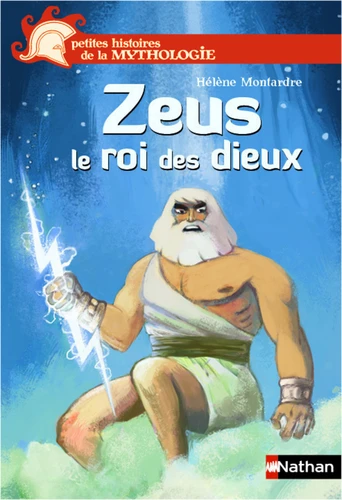Title of the work
Country of the First Edition
Country/countries of popularity
Original Language
First Edition Date
First Edition Details
Hélène Montardre, ill. Nicolas Duffaut, Zeus le roi des dieux [Zeus, King of the Gods]. Little Stories from Mythology [Petites histoires de la mythologie] 12. Paris: Nathan, 2013, 61 pp.
ISBN
Genre
Retelling of myths*
Target Audience
Children (9 years+)
Cover

Courtesy of the publisher.
Author of the Entry:
Elżbieta Olechowska, University of Warsaw, elzbieta.olechowska@gmail.com
Peer-reviewer of the Entry:
Lisa Maurice, Bar-Ilan University, lisa.maurice@biu.ac.il

Courtesy of Univers Jeunesse – Nathan – Syros – Pocket Jeunesse.
Nicolas Duffaut
, b. 1977
(Illustrator)
Born in 1977 in Aubenas, in the Ardèche region, he studied illustration at the Émile Cohl School in Lyons where he received his diploma in 2002. Since, he has been working as illustrator for a number of publishers, namely Bayard, Magnard, Flammarion, Milan jeunesse, Nathan, Sarbacane et Tourbillon. He also works for YA press. Among his illustrations connected to Antiquity are Homer’s Illiad and Odyssey:
L’Odyssée d’Homer, illustré par Nicolas Duffaut. Paris: Nathan, 2009
L’Iliade d’Homer illustré par Nicolas Duffaut, Folio Junior. Paris: Galimard Jeunesse, 2014.
Sources:
Profile at the editions-sarbacane.com (accessed: June 3, 2018);
Profile at the babelio.com (accessed: June 3, 2018);
Blog (accessed: June 3, 2018).
Interview on YouTube. Uploaded by Librairie Grangier, Illustrateur talentueux, Nicolas Duffaut nous parle de lui et de son travail (accessed: June 3, 2018).
Bio prepared by Elżbieta Olechowska, University of Warsaw, elzbieta.olechowska@gmail.com

Portrait, courtesy of Univers Jeunesse–Nathan–Syros–Pocket Jeunesse.
Hélène Montardre
, b. 1954
(Author)
Born in 1954 in Montreuil, in a family with origins in the Forez Mountains. Because of her father’s occupation (the writer Georges Montforez, 1921–1974), during her childhood and adolescence she frequently moved and lived in many different places: Saint-Étienne, Marvejols, Nantes, Loudun, Issoire. She studied English at the University of Clermont-Ferrand, where she obtained her PhD (L’image des personnages féminins dans la littérature de jeunesse française contemporaine de 1975 à 1995. Lille: Presses universitaires du Septentrion) in 1999. For the last forty years or so, she has lived with her family in the Haute-Garonne, Occitanie. During the last decade, she wrote a number of books based on a variety of Greek myths, with illustrations by Nicholas Duffaut; the books appeared in two series published by Nathan and called: Petites histoires de la mythologie and Contes et légendes jeunesse.
She has written over fifty books, mainly for children and received many literary awards:
- 1995 2nd prize for roman jeunesse du Ministère de la Jeunesse et des Sports;
- 1998 Price Livrami of the city of Pithiviers;
- 2003–2004 Price Tatoulu ;
- 2004 Price Livre, mon ami, New Caledonia;
- 2007 Price of the City of Cherbourg-Octeville, XVIIIe Livre d’Or des Jeunes Lecteurs Valenciennois, Price Ruralivres en Pas-de-Calais, Price Latulu des collégiens du Maine-et-Loire;
- 2007 and 2008 Price of Readers’ Spring, Narbonne, 2007–2008 Literary price of the Montagnes d’Auvergne;
- 2008 Price Jasmin, Agen, Price Trégor ados, Price Livrentête Culture et Bibliothèques Pour Tous, category Junior Novel.
Chronological bibliography of Hélène Montardre’s books related to classical antiquity
Non-fiction
- Hélène Montardre. L’Empire romain, Les Essentiels Junior. Toulouse: Milan, 2004.
- Hélène Montardre. La Grèce ancienne, Les Encyclopes. Toulouse: Milan, 2004.
- Hélène Montardre. La mythologie grecque, Les Encyclopes. Toulouse: Milan, 2008.
Series Petites histoires de la mythologie
- Hélène Montardre, Nicolas Duffaut, ill. Dans le ventre du cheval de Troie. Paris: Nathan, 2010.
- Hélène Montardre, Nicolas Duffaut, ill. Orphée aus Enfers, Paris: Nathan, 2013.
- Hélène Montardre, Nicolas Duffaut, ill. Les douze travaux d’Hercule. Paris: Nathan, 2011.
- Hélène Montardre, Nicolas Duffaut, ill. Zeus le roi des dieux. Paris: Nathan, 2013.
- Hélène Montardre, Nicolas Duffaut, ill. Héphaïstos et l'amour d'Aphrodite. Paris: Nathan, 2013.
- Hélène Montardre, Nicolas Duffaut, ill. Thésée contre le Minotaure. Paris :Nathan, 2013.
Series Contes et légendes jeunesse
- Hélène Montardre, Nicolas Duffaut, ill. Persée et la Gorgone. Paris: Nathan, 2010.
- Hélène Montardre, Nicolas Duffaut, ill. Jason et la Toison d'or. Paris: Nathan, 2011.
- Hélène Montardre, Nicolas Duffaut, ill. Le labyrinthe de Dédale. Paris: Nathan, 2011.
- Hélène Montardre, Nicolas Duffaut, ill. Ulysse et le Cyclope. Paris: Nathan, 2011.
- Hélène Montardre, Nicolas Duffaut, ill. L'enlèvement de Perséphone. Paris: Nathan, 2012.
- Hélène Montardre, Nicolas Duffaut, ill. Achille le guerrier. Paris: Nathan, 2012.
- Hélène Montardre, Nicolas Duffaut, ill. Pégase, l'indomptable. Paris: Nathan, 2012.
- Hélène Montardre, Nicolas Duffaut, ill. Prométhée, le voleur de feu. Paris: Nathan, 2012.
- Hélène Montardre, Nicolas Duffaut, ill. Apollon, le dieu dauphin. Paris: Nathan, 2015.
- Hélène Montardre, Nicolas Duffaut, ill. Les monstres de l'Odyssée. Paris: Nathan, 2016.
- Hélène Montardre, Nicolas Duffaut, ill. Hermès Le dieu aux mille dons. Paris: Nathan, 2017.
Source:
Website of the Maison des écrivains et de la littérature (accessed: June 26, 2018).
Bio prepared by Elżbieta Olechowska, University of Warsaw, elzbieta.olechowska@gmail.com
Summary
In the mountains on the island of Crete, in a secret clearing, nymphs live, sing, dance, and play undisturbed. A young boy called Zeus plays and runs in the hills trying to catch Amalthea, a goat with horns full of ambrosia. Zeus grows up and asks nymphs about his parents. At first, they speak only about his mother Rhea, but later they tell him about his father, Kronos, who, trying to prevent a prophecy, devours his children. Zeus was saved by Rhea, who gave birth to him on Crete and, to save his life, left him to Amalthea and the nymphs' care. Instead of her baby, she gave Kronos a stone wrapped in swaddling clothes and Kronos, convinced that it was his son, swallowed the stone. The boy realizes that once he reaches adulthood, he would have to rejoin his strange family. When the time comes, he goes to find his father, the gigantic Titan Kronos. While scared of his father, he stays his ground and tells him who he is. Kronos is so astounded that he begins to cough; first, he coughs out the diapered stone, then, one after another, all the babies he devoured. Once they touch the ground, they instantly begin to grow: Poseidon, Hades, Hera, Hestia, and Demeter. After his bout of coughing and regurgitating devoured children, Kronos lies on the ground, unconscious. His three sons and three daughters plan their strategy against their father and the rest of the Titans.
Zeus’ siblings are afraid of the Titans and think they have little chance of winning a war against them. Still, Zeus, brought up on stories told to him by the nymphs, knows all their potential allies: first, the Cyclopes, locked by Titans inside Gaia, then all the other deities that could be convinced to join. The best place from which the war could be conducted is Mount Olympus. Zeus goes to talk to the Cyclopes while his siblings try to coopt other gods. The Cyclopes make lightning bolts for Zeus and give him the ability to control the thunder. Finally, Zeus also releases three Hekatoncheires, hundred-handed giants: Briareus, Kottos, and Gyges. They have no problem standing on Olympus and showering the Titans with huge rocks. Zeus strikes the Titans with lightning after lightning. They are overwhelmed. Zeus asks the Hekatoncheires to chain the Titans, keeping them deep underground, imprisoning them in Tartarus, and standing guard there. After a time of peace, Gaia, to whose suffering nobody paid attention to, brings another plague against Olympus: Typhon, the strongest monster in the world. Zeus believes that if the Olympian gods work together, they can vanquish even Typhon. The battle evolves into a duel between Typhon and Zeus, from which, after a hard fight, Zeus emerges victorious. Typhon falls, and the earth opens and swallows him. Zeus’ hair and beard turned white during the duel, he also became taller, and his authority shines through. A new order of thing is being introduced: Zeus distributes power between the gods; Poseidon gets the seas, Hades the Underworld and the shades of the dead, Hera becomes the goddess of marriage, Hestia of the hearth, family, and home, Demeter of the harvest, Hecate takes the role of divine advisor, Aphrodite brings love, and so on, resulting in every goddess and god getting a special area of responsibility.
In the end, like in all books of the series, a Pour en savoir plus [To know more about it] section provides basic information about characters and sources.
Analysis
The myth of Zeus is retold from an unusual perspective, that of a child. During his idyllic childhood among nymphs on the Island of Crete, fed with ambrosia by his loving nurse, the goat Amalthea, Zeus is unaware of his parentage. As he grows up, he starts seeking answers to the eternal questions that all children who waere not brought up in their family have: who am I? Who and where are my parents? Why did they abandon me? When he learns the fantastic truth from his companions, the Nymphs, he decides to face his father. The story tells us how difficult it was for the young Zeus to stand up to the terrifying Kronos. There is a scene full of dramatic tension when Zeus explains to his disbelieving father that he is his son. Kronos laughs so much that he vomits, first the stone, and then coughs up all the children he swallowed. Montardre continues the story providing a summary overview of what happened until Zeus’ victory over the Titans and the division of power between the gods under his royal authority.
The young hero achieved his dream and recovered his rightful place in the world. This part of the myth is the most exciting and relevant for children. As in her other volumes in the series Les petites histoires de la mythologie, the author does not sanitize the myth for the young readers but highlights what can make the story relevant and presents it accordingly. She does not go into the gory details but does not distort the myth. Her modern language usage and style make the story accessible and the plot absorbing for children. The target age, as specified by the publisher, nine years and up, seems just right. The volume is an excellent introduction to Greek mythology and its perception by children.
Addenda
Genre: Short, illustrated retellings for children of individual myths or myths related to individual mythical figures.


